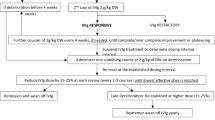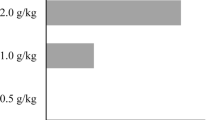Abstract
Intravenous immunoglobulins (IVIg) are effective for treating chronic inflammatory demyelinating polyneuropathy (CIDP), although treatment needs are variable and need to be individualized. Dose and frequency requirements are not currently predictable in advance. In Guillain–Barré syndrome, IVIg interpatient pharmacokinetic variations have been demonstrated in relation to clinical outcome. We studied 15 patients with CIDP following two routine courses of IVIg. IgG levels were assessed pretreatment and 14 days post-treatment. Best clinical response (BCR) was ascertained in each case, predefined, according to individual patients’ circumstances, on the 10 m walk, or MRC sum score, or Jamar grip dynamometry. Correlations between IgG level variations, doses administered, weight, body mass index, BCR and infusion interval were determined. Postinfusion rise in IgG levels were correlated in individual patients (p = 0.005), but interpatient variability was high. No correlations were ascertained between IgG level variation and weight, body mass index, BCR, total dose of IVIg administered, or dose of IVIg administered per kilogram per week. There were significant correlations between total dose administered and post-infusion IgG level at 14 days (p = 0.004) and between infusion interval and mean rise in IgG level (p = 0.001) These findings suggest significant variability in IgG metabolism between patients, unrelated to minimal effective dose administered, weight, body mass index or degree of functional improvement. Required frequency of IVIg infusions may, however, importantly relate to patient-specific post-infusion rise in IgG levels hence possibly explaining inter-patient differences in treatment frequency needs. IgG level monitoring may be helpful in establishing optimum treatment regimens in individual cases.



Similar content being viewed by others
References
Hughes RA, Swan AV, van Doorn PA (2010) Intravenous immunoglobulin for Guillain–Barré syndrome. Cochrane Database Syst Rev 6:002063
Jacob S, Rajabally YA (2009) Current proposed mechanisms of action of intravenous immunoglobulins in inflammatory neuropathies. Current Neuropharmacol 7:337–342
Rajabally YA, Seow H, Wilson P (2006) Dose of intravenous immunoglobulins in chronic inflammatory demyelinating polyneuropathy. J Peripher Nerv Syst 11:325–329
Kuitwaard K, de Gelder J, Tio-Gillen AP et al (2009) Pharmacokinetics of intravenous immunoglobulin and outcome in Guillain–Barré syndrome. Ann Neurol 66:597–603
van Doorn PA, Kuitwaard K, Jacobs BC (2011) Serum IgG levels as biomarkers for optimizing IVIg therapy in CIDP. J Peripher Nerv Syst 16(3):38–40
Kuitwaard K, van Doorn PA, van den Berg LH, et al (2013) Serum IgG levels in immunoglobulin treated chronic inflammatory demyelinating polyneuropathy. J Neurol Neurosurg Psychiatry (Epub ahead of print)
Van den Bergh PY, Hadden RD, Bouche P et al (2010) European Federation of Neurological Societies/Peripheral Nerve Society Guideline on management of chronic inflammatory demyelinating polyneuropathy: report of a joint task force of the European Federation of Neurological Societies and the Peripheral Nerve Society- First Revision. Eur J Neurol 17:356–363
Lunn MP, Manji H, Choudhary PP, Hughes RA, Thomas PK (1999) Chronic inflammatory demyelinating polyneuropathy: a prevalence study in south east England. J Neurol Neurosurg Psychiatry 66:677–680
Rajabally YA, Simpson BS, Beri S, Bankart J, Gosalakal J (2009) Epidemiologic variability of chronic inflammatory demyelinating polyneuropathy with different diagnostic criteria: study of a UK population. Muscle Nerve 39:432–438
Dalakas MC (2004) Intravenous immunoglobulin in autoimmune neuromuscular diseases. JAMA 291:2367–2375
van Nes SI, Vanhoutte EK, van Doorn PA et al (2011) Raasch-built overall disabilty Scale (R-ODS) for immune mediated peripheral neuropathies. Neurology 67:337–345
Acknowledgments
The authors are grateful to Dr. Peter Nightingale, Statistician, University Hospitals of Birmingham and University of Birmingham, Queen Elizabeth Hospital, Birmingham, UK for his help and advice with the verification of the statistical analysis and presentation of the data. Funding: none.
Conflicts of interest
Rajabally YA has received honoraria for consultancy from LfB France, CSL Behring and BPL. Rajabally YA has received educational sponsorships from LfB France and Baxter. Wong SL and Kearney DA have no disclosures.
Author information
Authors and Affiliations
Corresponding author
Rights and permissions
About this article
Cite this article
Rajabally, Y.A., Wong, S.L. & Kearney, D.A. Immunoglobulin G level variations in treated chronic inflammatory demyelinating polyneuropathy: clues for future treatment regimens?. J Neurol 260, 2052–2056 (2013). https://doi.org/10.1007/s00415-013-6938-7
Received:
Revised:
Accepted:
Published:
Issue Date:
DOI: https://doi.org/10.1007/s00415-013-6938-7




